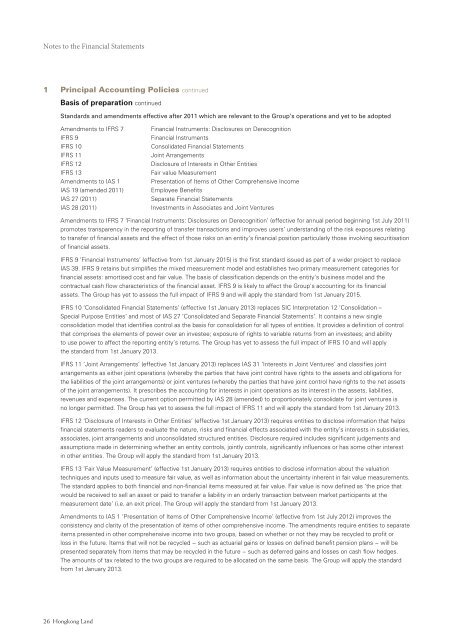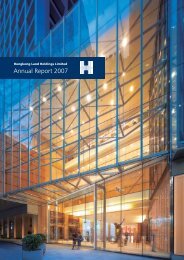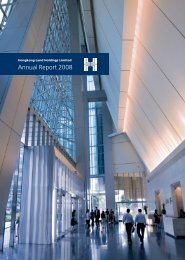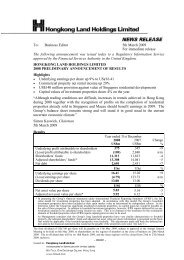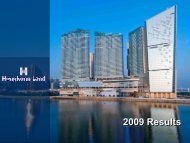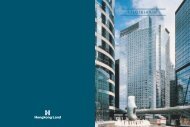Annual Report 2011 - Hongkong Land
Annual Report 2011 - Hongkong Land
Annual Report 2011 - Hongkong Land
You also want an ePaper? Increase the reach of your titles
YUMPU automatically turns print PDFs into web optimized ePapers that Google loves.
Notes to the Financial Statements<br />
1 Principal Accounting Policies continued<br />
Basis of preparation continued<br />
Standards and amendments effective after <strong>2011</strong> which are relevant to the Group’s operations and yet to be adopted<br />
Amendments to IFRS 7<br />
IFRS 9<br />
IFRS 10<br />
IFRS 11<br />
IFRS 12<br />
IFRS 13<br />
Amendments to IAS 1<br />
IAS 19 (amended <strong>2011</strong>)<br />
IAS 27 (<strong>2011</strong>)<br />
IAS 28 (<strong>2011</strong>)<br />
Financial Instruments: Disclosures on Derecognition<br />
Financial Instruments<br />
Consolidated Financial Statements<br />
Joint Arrangements<br />
Disclosure of Interests in Other Entities<br />
Fair value Measurement<br />
Presentation of Items of Other Comprehensive Income<br />
Employee Benefits<br />
Separate Financial Statements<br />
Investments in Associates and Joint Ventures<br />
Amendments to IFRS 7 ‘Financial Instruments: Disclosures on Derecognition’ (effective for annual period beginning 1st July <strong>2011</strong>)<br />
promotes transparency in the reporting of transfer transactions and improves users’ understanding of the risk exposures relating<br />
to transfer of financial assets and the effect of those risks on an entity’s financial position particularly those involving securitisation<br />
of financial assets.<br />
IFRS 9 ‘Financial Instruments’ (effective from 1st January 2015) is the first standard issued as part of a wider project to replace<br />
IAS 39. IFRS 9 retains but simplifies the mixed measurement model and establishes two primary measurement categories for<br />
financial assets: amortised cost and fair value. The basis of classification depends on the entity’s business model and the<br />
contractual cash flow characteristics of the financial asset. IFRS 9 is likely to affect the Group’s accounting for its financial<br />
assets. The Group has yet to assess the full impact of IFRS 9 and will apply the standard from 1st January 2015.<br />
IFRS 10 ‘Consolidated Financial Statements’ (effective 1st January 2013) replaces SIC Interpretation 12 ‘Consolidation –<br />
Special Purpose Entities’ and most of IAS 27 ‘Consolidated and Separate Financial Statements’. It contains a new single<br />
consolidation model that identifies control as the basis for consolidation for all types of entities. It provides a definition of control<br />
that comprises the elements of power over an investee; exposure of rights to variable returns from an investees; and ability<br />
to use power to affect the reporting entity’s returns. The Group has yet to assess the full impact of IFRS 10 and will apply<br />
the standard from 1st January 2013.<br />
IFRS 11 ‘Joint Arrangements’ (effective 1st January 2013) replaces IAS 31 ‘Interests in Joint Ventures’ and classifies joint<br />
arrangements as either joint operations (whereby the parties that have joint control have rights to the assets and obligations for<br />
the liabilities of the joint arrangements) or joint ventures (whereby the parties that have joint control have rights to the net assets<br />
of the joint arrangements). It prescribes the accounting for interests in joint operations as its interest in the assets, liabilities,<br />
revenues and expenses. The current option permitted by IAS 28 (amended) to proportionately consolidate for joint ventures is<br />
no longer permitted. The Group has yet to assess the full impact of IFRS 11 and will apply the standard from 1st January 2013.<br />
IFRS 12 ‘Disclosure of Interests in Other Entities’ (effective 1st January 2013) requires entities to disclose information that helps<br />
financial statements readers to evaluate the nature, risks and financial effects associated with the entity’s interests in subsidiaries,<br />
associates, joint arrangements and unconsolidated structured entities. Disclosure required includes significant judgements and<br />
assumptions made in determining whether an entity controls, jointly controls, significantly influences or has some other interest<br />
in other entities. The Group will apply the standard from 1st January 2013.<br />
IFRS 13 ‘Fair Value Measurement’ (effective 1st January 2013) requires entities to disclose information about the valuation<br />
techniques and inputs used to measure fair value, as well as information about the uncertainty inherent in fair value measurements.<br />
The standard applies to both financial and non-financial items measured at fair value. Fair value is now defined as ‘the price that<br />
would be received to sell an asset or paid to transfer a liability in an orderly transaction between market participants at the<br />
measurement date’ (i.e. an exit price). The Group will apply the standard from 1st January 2013.<br />
Amendments to IAS 1 ‘Presentation of Items of Other Comprehensive Income’ (effective from 1st July 2012) improves the<br />
consistency and clarity of the presentation of items of other comprehensive income. The amendments require entities to separate<br />
items presented in other comprehensive income into two groups, based on whether or not they may be recycled to profit or<br />
loss in the future. Items that will not be recycled − such as actuarial gains or losses on defined benefit pension plans − will be<br />
presented separately from items that may be recycled in the future − such as deferred gains and losses on cash flow hedges.<br />
The amounts of tax related to the two groups are required to be allocated on the same basis. The Group will apply the standard<br />
from 1st January 2013.<br />
26 <strong>Hongkong</strong> <strong>Land</strong>


